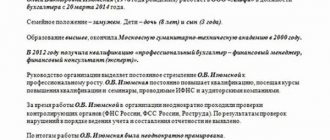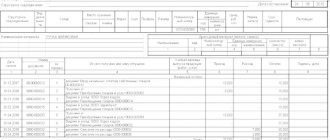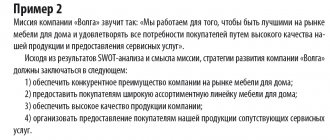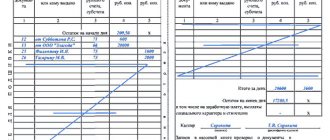Accounting policy of an enterprise: general requirements for registration
The accounting policy is drawn up in accordance with the rules established by the accounting law No. 402-FZ of December 6, 2011, as well as PBU 1/2008. In addition, each industry may have its own regulations that affect its content.
The accounting policy consists of two parts: accounting and tax. They can be drawn up as a single document consisting of two sections, or two separate provisions can be made.
The organization's accounting policies are applied continuously from year to year, and reasonable changes to it can only be made from the beginning of the reporting year. The order on the accounting policy is approved by the manager no later than 90 days after registration of the company. For example, the accounting policy for 2020 should have been adopted before December 31, 2019, and the document approved in 2020 will come into force only on January 1, 2021.
An organization's accounting policies should reflect accounting methods only for actual assets, transactions, and liabilities. It is advisable to fix in the text of the document those accounting aspects for which there is a choice from several options, or the law does not contain an unambiguous interpretation on them. For example: what methods of depreciation are used, how reserves are created, etc. It makes no sense to rewrite unambiguous provisions of the PBU, or the Tax Code, that do not offer a choice.
Accounting info
In Russia, a four-level system of regulatory regulation of accounting has developed:• first level – the Law “On Accounting”, other federal laws, decrees of the President of the Russian Federation and resolutions of the Government of the Russian Federation on accounting issues;
• second level – Accounting Regulations;
• third level – guidelines, instructions, recommendations and other similar documents of the Ministry of Finance of Russia;
• fourth level – internal documents of a specific organization.
The first three levels of the system are the prerogative of the state.
The fourth level is formed by the organization based on the specifics of its business.
The inclusion of internal documents of an organization in the regulatory system does not mean complete freedom of the organization in developing the content of these documents and the procedure for their adoption. The state controls this process through its reflection and disclosure in regulations governing accounting and financial reporting issues in the Russian Federation.
As the main document of the fourth level, regulatory documents consider the accounting policy of the organization.
According to paragraph 3 of Art. 5 “Regulation of Accounting” of the Law “On Accounting”: “...organizations, guided by the legislation of the Russian Federation on accounting, regulations of bodies regulating accounting, independently form their accounting policies based on their structure, industry affiliation and other features of their activities "
Provision PBU 1/98 “Accounting policy of an organization” (approved by Order of the Ministry of Finance of Russia dated December 9, 1998 No. 60n) is a fundamental regulatory document that should guide an organization when forming and disclosing its accounting policy.
The regulation includes four sections:
I. General provisions;
II. Formation of accounting policies;
III. Disclosure of accounting policies;
IV. Change in accounting policy.
In accordance with PBU 1/98, the accounting policy of an organization is understood as the set of accounting methods adopted by it - primary observation, cost measurement, current grouping and final generalization of the facts of economic activity.
Accounting methods include:
• techniques for organizing document flow,
• methods of using the accounting register system,
• methods of information processing,
• techniques for organizing inventory,
• methods of using accounting accounts,
• methods of grouping and assessing facts of economic activity,
• methods of repaying the value of assets,
• other methods and techniques.
When forming an accounting policy on a specific issue of maintaining and organizing accounting, one chooses one of the methods allowed by the legislation and regulations governing accounting in the Russian Federation.
The organization's accounting policies must meet the requirements of completeness, prudence, priority of content over form, consistency and rationality.
Organizations are independent in forming accounting policies. However, this independence must be deliberately limited in order to develop accounting methods that allow for the effective exchange of reporting information, for example, within a group of organizations.
The composition of participants in the process of developing accounting policies (chief accountant, company management, methodologists and employees of functional services, internal and external consultants) depends on the size of the organization.
When involving consultants in the development of accounting policies, it is necessary to carefully approach the formulation of the terms of the contract and determine the scope of the consultant's services and responsibilities.
Establishing the responsibility of the manager for organizing accounting and compliance with the law when performing business transactions (clause 1, article 6), the Law “On Accounting” names the chief accountant of the organization as the person responsible for the formation of accounting policies (clause 2, article 7 ). At the same time, the Law “On Accounting” defines the organization itself as the subject of the process of forming accounting policies without specifying any specific officials (clause 3 of article 5). In accordance with paragraph 3 of Art. 6 the adopted accounting policy is approved by order or order of the person responsible for the organization and state of accounting (i.e., based on the norm of paragraph 1 of Article 6 - the head of the organization).
Thus, in accordance with the Law “On Accounting”:
• the organization forms accounting policies;
• the chief accountant is responsible for the formation process;
• the manager approves the adopted accounting policy and is responsible for its content (since he is generally responsible for the organization of accounting and compliance with legislation when carrying out business transactions).
The norm of legislation on accounting policies imposes great responsibility on the head of the organization and the chief accountant and requires good knowledge of the methodology and organization of accounting, taxation, finance and other issues.
If the organization does not have an accounting department or a full-time accountant, such a person may be the head of the organization, since the Law “On Accounting” entrusts him with full responsibility for organizing accounting.
The text of PBU 1/98 includes the norm of the Law “On Accounting” and the Regulations on Accounting and Financial Reporting in the Russian Federation (approved by Order of the Ministry of Finance of Russia dated July 29, 1998 No. 34n) regarding the list of issues approved during the formation of accounting policies. These include:
• working chart of accounts, containing synthetic and analytical accounts necessary for maintaining accounting records in accordance with the requirements of timeliness and completeness of accounting and reporting;
• forms of primary accounting documents used to document facts of economic activity, for which standard forms of primary accounting documents are not provided
• forms of documents for internal accounting reporting;
• the procedure for conducting an inventory of the organization's assets and liabilities;
• methods for assessing assets and liabilities;
• document flow rules and technology for processing accounting information;
• the procedure for monitoring business operations;
• other issues whose solution is necessary to organize accounting.
Thus, conditionally, the entire set of issues resolved with the help of accounting policies can be divided into methodological and organizational-technical.
Methodological issues of an organization's accounting policy affect the procedure for generating the financial results of the organization's activities and the assessment of its financial condition.
Organizational and technical issues of an organization's accounting policy include techniques and methods for organizing the technological process of the accounting and financial service of an enterprise, aimed at successfully completing the tasks facing the information system that ensures the process of making economic decisions.
The most difficult, perhaps, is the problem of resolving disputes when making decisions on choosing one or another method of accounting. The choice of a specific option can significantly affect the volume of accounting work and the division of responsibility for certain accounting processes.
We can talk about the timing of the formation of accounting policies only in relation to newly created organizations.
All other organizations, that is, organizations that exist for more than one reporting period, were required to formulate an accounting policy in the reporting period for which the first financial statements were presented. The accounting policy adopted by the organization must be applied consistently from year to year, undergoing changes only in cases established by law (clause 4 of article 6 of the Law “On Accounting”).
Thus, “old” organizations can only talk about changes or additions to previously formed accounting policies, even if its content is changed by 100%.
The deadlines for the formation and execution of accounting policies are established in paragraph 10 of PBU 1/98: “A newly created organization draws up its chosen accounting policies in accordance with this paragraph before the first publication of financial statements, but no later than 90 days from the date of acquisition of the rights of a legal entity (state registration) . The accounting policy adopted by the newly created organization is considered to be applied from the date of acquisition of the rights of a legal entity (state registration).”
All decisions made by the organization are necessarily enshrined in the order on accounting policies (clause 3 of article 6 of the Law “On Accounting”).
Order on the accounting policies of organizations for 2007. must be dated no later than December 31, 2006, that is, no later than the accounting period from which the accounting policy is put into effect.
Taxpayers must have at least two provisions on accounting policies: “Accounting policies for accounting”, “Accounting policies for taxation”.
Accounting policies for accounting.
Accounting policies are developed as a whole as a strategy for the accounting process for an organization with the need to maintain consistency in its application. Through the accounting policy, it is necessary to prescribe, for example, how to calculate depreciation: using the straight-line method or the reducing balance method, this is a set of issues that determines the system for maintaining the accounting process in the organization, which is formed and developed throughout the year.
The corresponding organizational and administrative documentation that formalizes the accounting policy in the organization for accounting may contain the following sections.
1. Organization of the accounting department. Organization of document flow. Accounting register system. The organization independently establishes the organizational form of accounting work, based on the type of organization and specific business conditions. The organization of the accounting service includes the rights and responsibilities of the chief accountant (or the accountant performing his functions), the procedure for interaction of the accounting service with other services, the organizational structure of the accounting department, etc.
2. Accounting system and methods of processing accounting information. Today, the most common accounting system is using software using a journal of business transactions with continuous numbering of the latter.
3. Organizing an inventory of property and monetary obligations. Inventory is a physical count of the company’s assets and reconciliation of its liabilities.
The number of inventories in the reporting year, the dates of their conduct, the list of property and liabilities checked during each of them are established by the head of the organization, except in cases where an inventory is required.
4. Methods of using accounting accounts. When maintaining accounting records, organizations are guided by the Chart of Accounts for accounting the financial and economic activities of organizations (Order of the Ministry of Finance dated October 31, 2000 No. 94n).
This Chart of Accounts is typical. The head of the organization approves the Working Chart of Accounts, which contains the accounts used in the organization and necessary for maintaining synthetic and analytical accounting. At the same time, the content of individual subaccounts (second-order accounts) is clarified, subaccount data is excluded or combined, and additional subaccounts are introduced.
5. Method of calculating depreciation of fixed assets. Depreciation of fixed assets can be carried out in one of the following ways: linear; write-off of cost in proportion to the volume of insurance services provided; reducing balance; write-off of cost based on the sum of the numbers of years of useful life.
Moreover, the last three methods are applied to fixed assets put into operation since 01/01/1998.
6. Method of paying off the cost of MBPs in operation.
7. List of intangible assets and depreciation rates for them. Depreciation on intangible assets is accrued monthly at rates determined by the organization based on the established useful life established by the organization independently.
8. List of deferred expenses and deadlines for their write-off. Expenses incurred in the reporting period, but related to the following reporting periods, are reflected in the statements as deferred expenses and are subject to write-off to the cost of insurance services (or to the appropriate sources of funds of the organization) during the period to which they relate.
9. Other sections of accounting policies. Any organization may provide for other sections of accounting policies predetermined by the Regulations on Accounting and Financial Reporting in the Russian Federation, the Accounting Regulations “Accounting Policy of an Enterprise” (PBU 1/98) and other regulatory documents.
So, for example, if an organization has branches, then the accounting policy must provide for a system for organizing work with branches (deadlines for submitting accounting/financial reports to the parent company, a system for monitoring the activities of branches, their accounting work, etc.).
The organization must disclose the accounting methods adopted when forming its accounting policies, which significantly influence the assessment and decision-making of interested users of the financial statements.
Accounting methods are considered essential, without knowledge of the application of which by interested users of financial statements it is impossible to reliably assess the financial position, cash flow or financial results of the organization.
Issues of changing accounting policies require special attention. The fact that in PBU 1/98 a separate section is devoted to them is evidenced by how significant these issues are at the present time.
PBU 1/98 (clause 16) specifies the norm of clause 4 of Art. 6 of the Law “On Accounting” and provides for the following cases in which the accounting policy of an organization may be changed:
• changes in the legislation of the Russian Federation or regulatory acts on accounting;
• development by the organization of new methods of accounting. The use of a new method of accounting requires a more reliable representation of the facts of economic activity in the accounting and reporting of the organization or less labor intensity of the accounting process without reducing the degree of reliability of the information;
• significant change in operating conditions. A significant change in the operating conditions of an organization may be associated with reorganization, change of owners, change in types of activities, etc.
As you can see, the list of possible options for changing the operating conditions provided for by PBU 1/98 is not closed.
PBU 1/98 (clause 16) defines: “It is not considered a change in accounting policy to approve the method of accounting for facts of economic activity that are essentially different from facts that occurred previously, or that arose for the first time in the organization’s activities.”
This means that an organization can make additions to its accounting policies as new facts of economic activity that have not taken place before arise, rather than trying to “guess” all possible operations that the organization will carry out in the future when forming an accounting policy.
Changes in accounting policies are documented in the relevant organizational and administrative documentation in the same manner as the accounting policies are drawn up when adopted (clause 17 of PBU 1/98).
Accounting policy for tax purposes.
Just a few years ago, many organizations did not formulate accounting policies for tax purposes at all as a separate document. Some elements of such a policy were part of the company's unified accounting policy. There, at the same time, there were both applicable accounting rules and rules regarding the procedure for calculating and paying certain types of taxes.
Everything changed dramatically after Ch. 21 “Value added tax” and 25 “Tax on corporate profits” of part two of the Tax Code of the Russian Federation.
The text of these chapters directly contains a requirement to formulate a special accounting policy for tax purposes.
However, this does not mean that the organization should limit itself only to drawing up an accounting policy for value added tax (VAT) and corporate income tax. The Tax Code of the Russian Federation contains quite a lot of other issues that require the company to choose one or another course of action.
Consequently, an accounting policy for tax purposes is a document in which the taxpayer is obliged to prescribe all the rules and methods that he intends to follow when calculating and paying taxes and fees.
In this case, an organization can choose one of two options for drawing up tax accounting policies:
1) reflect individual issues for each tax in the relevant sections of the single order on tax accounting policy;
2) draw up separate accounting policies for each tax and approve them as appendices to the order on accounting policies for tax purposes.
Accounting policies for tax purposes should reflect three main points.
Firstly, this is the organizational and technical part:
• organization of tax accounting: by accounting employees, by creating a separate specialized unit, outsourcing (involving a specialized third-party organization to perform certain types of work), etc.;
• development of a tax register system for calculating corporate income tax;
• development of a document flow system for filling out tax registers, etc.
Secondly, and this is the most important part of the tax accounting policy, it must record the organization’s choice of tax legislation, the right to choose which belongs to the taxpayer. For a number of issues regarding taxation procedures, legislation provides the right to choose an accounting method from several possible options.
Thirdly, on some important issues of tax calculation, tax legislation is either absent altogether or is explained so vaguely that it requires additional clarification in the company’s tax accounting policy.
The latter is very important for relations with the tax office. A correctly drawn up accounting policy for tax purposes will help avoid many controversial situations. If suddenly a dispute with the tax authority goes into court, then in court the tax accounting policy of the organization will serve as a serious argument in its favor.
However, when developing an accounting policy, the taxpayer does not need to provide rules for all possible cases.
When developing an accounting policy, it is necessary to proceed from the situation in which the organization actually finds itself, to determine the immediate prospects for its activities and, on this basis, to highlight those issues that should really be reflected in the document being drawn up.
The obligation to draw up and adopt tax accounting policies is enshrined in several chapters of part two of the Tax Code of the Russian Federation:
• art. 167 ch. 21 “Value added tax”;
• art. 313 ch. 25 “Organizational profit tax”;
• clause 2 of Art. 339 ch. 26 “Mineral extraction tax”;
• clause 16 art. 346.38 ch. 26.4 “Taxation system for the implementation of production sharing agreements.”
There is no uniform procedure for drawing up accounting policies for tax purposes in our legislation. Therefore, in ch. 21 “Value added tax” and in chap. 25 “Corporate Income Tax” contains various instructions for approving accounting policies. Other chapters of the Tax Code of the Russian Federation do not contain anything specific about tax accounting policy in their text.
Theoretically, for tax purposes, it is not necessary to draw up a new accounting policy every year. Indeed, in tax accounting, as in accounting, the principle of consistency of accounting policies is applied. Once adopted, an accounting policy is applied until changes are made to it, that is, it must be applied for a long time. However, in practice this is almost impossible. The fact is that our tax legislation changes with such alarming frequency that sometimes it is easier to approve a new tax accounting policy than to make changes to the old one.
By the way, it is very important to take into account that the tax accounting policy is uniform for the entire organization and is mandatory for all its divisions - both existing ones and those that will be created in the future. With regard to VAT, this rule is directly enshrined in clause 12 of Art. 167 Tax Code of the Russian Federation.
In most cases, the structure of a company's tax accounting policy consists of two sections.
The first section describes general issues related to taxation.
1. The procedure for organizing tax accounting is indicated. To begin with, indicate which department will deal with this issue: accounting or a specialized service. Often, it is a separate department that has to deal with tax accounting problems, since now accounting and tax accounting have been divided into two systems that are no longer very similar to each other.
2. Issues of interaction with separate divisions of the organization are reflected. In particular, as stated in Art. 26 of the Tax Code of the Russian Federation, a taxpayer can participate in relations regulated by legislation on taxes and fees through his legal or authorized representative. Such a representative for an organization may be its separate division. On this basis, a number of taxes can be calculated directly in a separate division. At the same time, the tax base necessary for the calculation is formed there. But with such an organization of tax accounting, it is necessary to prescribe the procedure for transferring all necessary information from a separate division to the parent organization and back. Thus, the tax accounting policy should fix the deadline for submitting information to the head office for the preparation of consolidated accounting for the company as a whole.
The second section should reflect those options for forming the tax base for specific taxes that allow you to choose the current legislation:
• for VAT;
• for corporate income tax;
• for mineral extraction tax;
• for excise taxes;
• for taxation during the implementation of production sharing agreements.
The majority of this section of accounting policy will be occupied by corporate income tax. Chapter 25 “Organizational Income Tax” of the Tax Code of the Russian Federation contains a lot of different opportunities for the taxpayer to independently select elements of tax policy.
Order on accounting policyOrder No. _________ dated ________________On the accounting policy of the organization for 2006 I order to establish the following procedure.1. Accounting is maintained in accordance with Federal Law No. 129-FZ dated February 23, 1996 “On Accounting”, Regulations on Accounting and Financial Reporting in the Russian Federation (approved by Order of the Ministry of Finance of Russia dated July 29, 1998 No. 34n), Regulations on Accounting accounting, the Chart of Accounts for accounting the financial and economic activities of organizations and the Instructions for its application, approved by Order of the Ministry of Finance of Russia dated October 31, 2000 No. 94n.2. The initial cost of intangible assets is repaid in a straight-line manner based on the norms calculated by the organization based on their useful life (clause 15 of PBU 14/2000 “Accounting for intangible assets”).3. Depreciation charges for intangible assets are reflected in accounting by accumulating the corresponding amounts on account 05 “Depreciation of intangible assets” (clause 21 of PBU 14/2000).4. Fixed assets used by the organization for a period exceeding 12 months, with a cost of no more than 10,000 rubles. per unit, are written off as production costs as they are released into production or operation (clause 18 of PBU 6/01 “Accounting for fixed assets”).5. Depreciation of fixed assets is calculated using the straight-line method (clause 18 of PBU 6/01). Considering that fixed assets are operated in a normal environment, in a normal shift mode, and the organization is created for an indefinite period, the useful life is established when the objects are accepted for accounting within the time limits established for these fixed assets in the Classification of fixed assets included in depreciation groups ( Decree of the Government of the Russian Federation dated January 1, 2002 No. 1).6. Accounting for the process of purchasing and procuring materials is carried out in the assessment at actual cost using account 10 “Materials” (according to the Chart of Accounts and Instructions for its use).7. When releasing inventories into production and otherwise disposing of them, they are assessed at the average cost (clause 16 of PBU 5/01 “Accounting for inventories”).8. Work in progress is valued at the actual production cost (clause 64 of the Regulations on accounting and financial reporting in the Russian Federation).9. Accounting for production costs is carried out by dividing them into direct (collected in the debit of accounts 20 “Main production” and 23 “Auxiliary production”) and indirect (reflected in the debit of accounts 25 “General production expenses” and 26 “General expenses”). At the end of the reporting period, indirect costs are included in the cost of products (works, services) as a result of the distribution: debit of accounts 20 or 23 – credit of accounts 25 or 26 according to ownership. The full actual production cost of products (works, services) is calculated (clause 9 of PBU 10/99 “Organization expenses”).10. Indirect expenses collected in the debit of accounts 25 “General production expenses” and 26 “General operating expenses” are distributed between types of products (works, services) - objects of calculation in proportion to direct wages (wages of main production workers). 11. Costs for the repair of fixed assets are included in the cost of the reporting period in which the repair work was carried out (clause 27 PBU 6/01 “Accounting for fixed assets”, clauses 5, 7 PBU 10/99 “Organization expenses”).12. Selling expenses are recognized in full in the reporting year of their recognition as expenses for ordinary activities (clause 9 of PBU 10/99 “Expenses of the organization”).13. Finished products are valued in the balance sheet at the actual production cost (clause 59 of the Regulations on accounting and financial reporting in the Russian Federation).14. Accounting for the output of finished products is organized without using account 40 “Output of products (works, services)” (Chart of Accounts and Instructions for its use). 15. Goods are reflected in accounting at actual cost, which includes the costs of procuring and delivering goods to central warehouses (bases) until they are put on sale (clause 13 of PBU 5/01 “Accounting for inventories”).16. Long-term debt on received loans and (or) credits is transferred to short-term debt at the moment when, according to the terms of the loan and (or) credit agreement, 365 days remain until the repayment of the principal amount of the debt (PBU 15/01 “Accounting for loans and credits and the costs of servicing them” ).17. A reserve is created for the upcoming payment of vacations to employees (clause 72 of the Regulations on accounting and financial reporting in the Russian Federation).18. A reserve for doubtful debts is created (clause 70 of the Regulations on accounting and financial reporting in the Russian Federation). Director of the enterprise _____________________________________ (signature)
Comments:
- In contact with
Download SocComments v1.3
| Next > |
“Accounting policies of the organization” PBU 1/2008: changes
From 08/06/2017, amendments to PBU 1/2008 “Accounting Policy of the Organization” came into force (Order of the Ministry of Finance of the Russian Federation dated 04/28/2017 No. 69n). Its provisions include, in particular, the following innovations:
- PBU “Accounting Policies” now applies to all legal entities, except credit and government organizations,
- a rule has been introduced on independent choice of the accounting method, regardless of the choice of other organizations, and subsidiaries choose from the standards approved by the main company (clause 5.1),
- the concept of rational accounting has been clarified - accounting information must be useful enough to justify the costs of its formation (clause 6),
- in cases where there is no specific method of accounting in federal standards, the organization develops it itself, based on paragraphs. 5 and 6 PBU 1/2008 and accounting recommendations, consistently referring to IFRS standards, federal (PBU) and industry accounting standards (clause 7.1), and to companies conducting simplified accounting (small enterprises, non-profit organizations, Skolkovo participants) , when forming an accounting policy, it is enough to be guided by the requirements of rationality (clause 7.2),
Other nuances
Other details of the document to note:
- Mandatory individuality . When developing, the specifics of the company’s activities should be taken into account (investment needs, industry characteristics, short-term and long-term management plans and other factors).
- High flexibility . There should be links to the organization’s corporate local standards with their further development.
- Maximum use of rights granted by law . All details of the Accounting Regulations, Chapter 25 of the Tax Code, and other legislative provisions affecting the activities of the enterprise must be signed.
- Validity . References to the acts for which solutions are proposed must be indicated.
Contents of the accounting policy of the organization (LLC)
Accounting policies should reflect:
- list of regulations on the basis of which the company keeps records: Law on Accounting No. 402-FZ, PBU, Tax Code of the Russian Federation, etc.,
- working chart of accounts, prepared as an annex to the accounting policy,
- positions responsible for organizing and maintaining records in the company,
- forms of the “primary” used, accounting and tax registers - unified forms, or independently developed,
- depreciation issues – calculation methods, frequency (monthly, once a year, etc.),
- limits on the value of fixed assets, the procedure for their revaluation,
- accounting of materials, finished products, goods,
- accounting of income and expenses,
- the procedure for correcting significant errors and the criteria for classifying them,
- other provisions that the organization deems necessary to reflect.
If the “accounting” part of the organization’s accounting policy is quite universal for everyone, then the tax part will be different for each taxation regime, but in any case should contain:
- information about the applicable tax system, and if there is a combination of tax regimes - the procedure for maintaining separate accounting,
- how taxes are paid in separate divisions, if any,
- whether the company has tax benefits, and under what conditions they apply.
Alteration
The document can be changed in the following situations:
- when using a new method of accounting with a more reliable representation of the facts of activity in the company’s reports and accounting or low labor intensity without reducing the reliability of the information;
- when Russian laws or regulations on accounting change;
- when developing new methods of accounting within the company;
- with a significant change in working conditions.
A significant change in the operating conditions of an organization occurs when there is a change of owners, reorganization, change in specialization, reduction or expansion of production volumes, restructuring, etc.
Changes in documentation must be justified and executed in the appropriate manner. They are introduced from the beginning of the new year, which follows after their approval.
The assessment of the consequences of changes that may affect the financial flow, cash position or results of operations of the company is expressed in money. The assessment is carried out based on verified data for the period from which the changed accounting methodology is used. Significant methods of its maintenance must be disclosed in the explanatory note attached to the reports for the past period. Interim reports may not include accounting policies if there have been no changes to them during the previous year.
Changes that may have a significant impact on the financial flow, cash results or position of the company are subject to separate disclosure in the financial statements. Such information should reflect the reason for the changes, their assessment in financial terms, and an indication of the correction of data included in the financial statements.
Accounting policy of the simplified tax system
The nuances of tax accounting policy with “simplified” depend on the selected object: “income” (6%), or “income minus expenses” (15%).
When applying the simplified tax system “income”, tax policy should reflect:
- income accounting procedure,
- indicate how the paid insurance premiums reduce the tax base,
- in what order and at what rate are taxes and advance payments calculated,
- tax register - KUDIR.
With the object “income minus expenses”, special attention should be paid not only to income, but also to expenses, indicating:
- the procedure for accounting for fixed assets, the method of calculating depreciation,
- composition of material costs,
- procedure for accounting for sales costs (if any),
- recognition of past losses in the current period,
- procedure for calculating and paying the minimum tax,
Otherwise, the tax policy points will be similar to those indicated for the simplified tax system for “income”.
Primary documents and tax registers
If the form of the primary document is not approved in the accounting policy, then during a tax audit this document, and therefore the business transaction executed by this document, will not be accepted for accounting. This applies, first of all, to business transactions regarding expenses. And, if the expenses are not accepted, then the tax will be additionally charged.
If the primary document contains all the necessary information and does not require additional calculations, then it can be directly entered into KUDiR. If any additional calculation is required or when there are quite a lot of documents of the same type, then tax registers are needed.
Tax registers are paper or electronic tables where tax accounting data is entered - the monetary results of similar business transactions.
Example
For example, funds were received in an individual entrepreneur’s bank account to pay for goods. All money received constitutes the proceeds of the sale and is income. He enters the amount of revenue in KUDiR on the basis of a payment order. But if an individual entrepreneur receives not one payment order, but hundreds, in one day, then it is easier to first enter similar transactions in the tax register, and the total for the day in KUDiR. Maintaining such a register or directly entering each payment document into KUDiR should be specified in the accounting policy.
OSNO accounting policies
One of the main points of tax policy under OSNO is accounting for income tax. The document should reflect:
- procedure for recognizing direct and indirect expenses of an enterprise (cash or accrual method),
- the procedure for accounting for fixed assets, whether increasing coefficients are used for depreciation, depreciation bonus, for which objects,
- methods for assessing materials, raw materials and goods,
- Are reserves formed to evenly distribute expenses throughout the year (vacations, bad debts, OS repairs, etc.),
- accounting for transactions with securities,
- in what order is income tax and advance payments on it calculated and paid,
- applicable tax registers, etc.
The specifics of VAT accounting when developing accounting policies should be pointed out to those who are exempt from tax or who carry out transactions taxed at a rate of 0% - this concerns the order of distribution of “input” VAT.
In accounting
The document called accounting policy for accounting purposes discusses general accounting practices and industry specifics.
Regardless of the type of activity, organizations claim:
- working chart of accounts and forms of primary documents;
- a method of controlling the procurement, acquisition and write-off of inventories;
- method of calculating depreciation;
- error correction procedure.
Trade organizations indicate the method of reflecting transportation and procurement costs - in the cost of the goods or as they are sold.
Retail trade organizations indicate the method of accounting for goods - at purchase prices without markup.
Organizations with a long production cycle indicate the method of recognizing income as work, services, and products are ready.








